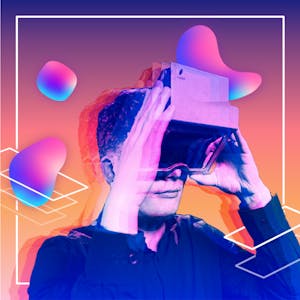User Experience & Interaction Design for AR/VR/MR/XR
This second course in the XR for Everybody specialization looks at how to design new user experiences for XR technologies. The course provides learners with a design thinking mindset and equips them with a fundamental toolbox for creating XR applications using rapid prototyping. It starts with a broad overview of the complete XR design process, discussing different paths to becoming an XR creator, what is generally involved in making XR experiences, and how to best get started. The course then emphasizes design thinking, critiques, and ethics while introducing guidelines and user-centered techniques like design jams. The second half of the course introduces a variety of methods and tools for prototyping both physically and digitally including on the XR devices themselves through immersive authoring.The course has an honors track that guides learners through creating their own storyboard, physical prototype, and digital prototype of an XR experience. You will work on exercises that allow you to practice your design skills and also build XR technologies into your workflow by working with specific templates and new digital tools that allow you to preview physical prototypes on AR/VR devices.
Critique new and existing XR experiences from an ethical standpoint.
Create storyboards and physical prototypes of new XR experiences.
Create XR prototypes with digital and immersive authoring tools.
Infer technical requirements for implementing your XR prototypes.
Syllabus
Syllabus - What you will learn from this course
Week 1
XR Design Process
Week 2
Design Thinking, Ethics, and Guidelines for XR
Week 3
Storyboarding & Physical Prototyping for XR Experiences
Week 4
Digital Prototyping & Evaluation of XR Experiences
FAQ
When will I have access to the lectures and assignments?
Access to lectures and assignments depends on your type of enrollment. If you take a course in audit mode, you will be able to see most course materials for free. To access graded assignments and to earn a Certificate, you will need to purchase the Certificate experience, during or after your audit. If you don't see the audit option:
What will I get if I subscribe to this Specialization?
When you enroll in the course, you get access to all of the courses in the Specialization, and you earn a certificate when you complete the work. Your electronic Certificate will be added to your Accomplishments page - from there, you can print your Certificate or add it to your LinkedIn profile. If you only want to read and view the course content, you can audit the course for free.
What is the refund policy?
If you subscribed, you get a 7-day free trial during which you can cancel at no penalty. After that, we don’t give refunds, but you can cancel your subscription at any time. See our full refund policy.
Is financial aid available?
Yes. In select learning programs, you can apply for financial aid or a scholarship if you can’t afford the enrollment fee. If fin aid or scholarship is available for your learning program selection, you’ll find a link to apply on the description page.
Do I need to know a lot about AR/VR?
No. This course briefly reviews key concepts and technologies in XR. However, the first course in the specialization provides a stronger foundation. This course is focused on AR/VR design. It takes established principles, methods, and tools that you may be familiar with from traditional user experience and interaction design, which is often focused on web and mobile, and transfers that knowledge to XR.
Do I need to have programming experience?
No. This course is targeted at a broad audience. There are no programming exercises associated with it. A design background is useful but not required either. If you already have experience developing with XR technologies, this course will help you adopt a more user-centered approach.
Do I need access to AR/VR devices?
No. To complete the main track of the course, it is recommended but not required. However, to complete the honors track, you will need access to AR/VR devices. To give AR a try, you need to have access to a smartphone. For VR, we do not recommend a particular device. It would be sufficient to use a Google Cardboard compatible display wrapper that turns your smartphone into VR goggles.
Reviews
This course was realy an eye opener on "how to design for XR". Loved it and felt valuable.
Fantastic Course with a great instructor. Highly recommended,
This is a great introduction with hands-on projects regarding user experience & interaction design for XR!
Best course I've taken on Coursera! People interested in XR should take this class -- the design process is so important!
